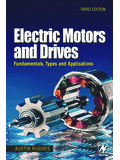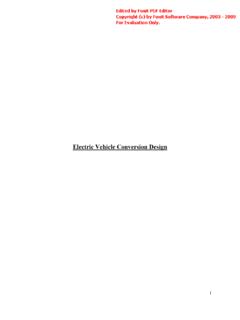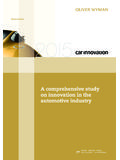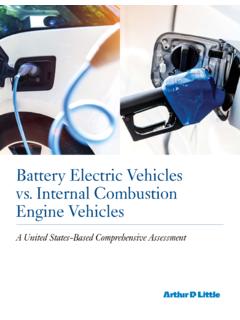Transcription of Battery Electric Vehicles
1 Battery Electric Vehicles Performance, CO2 emissions, lifecycle costs and advanced Battery technology development Daan Bakker August 2010. Battery Electric Vehicles Performance, CO2 emissions, lifecycle costs and advanced Battery technology development Master thesis Sustainable Development, Energy and Resources Copernicus institute University of Utrecht Supervisor Prof. Dr. Andre Faaij Author Daan Bakker Student number: 3142051. E-mail: Date of publication: August 2010. Report number: NWS-S-2010-16. 2. Summary The coming years a few Electric Vehicles will emerge on the market that are powered by a rechargeable Battery . The success of the Battery Electric vehicle (BEV) is very dependent on the Battery technology. This study tries to gain insight in the Battery types suitable for Electric Vehicles and the development of advanced batteries the coming decade.
2 Also a comparison is made between passenger Vehicles powered by petrol or diesel and a few Battery Electric Vehicles that will be introduced the coming years. A consortium of car manufacturers, the USABC, set up the goals that advanced batteries should have in order for the Battery Electric vehicle to become a commercial success. The specifications of a number of Battery types are compared with the USABC goals. None of the commercially available batteries suitable for Electric Vehicles can meet the minimum goals from the USABC, required for successful commercialisation. Especially the price of a Battery pack is a large burden for successful commercialisation. The lithium-ion Battery is the best candidate that can meet the required goals within years, except for the price goal. Another type of Battery that will meet the required specifications the next decade is the zebra Battery .
3 After 2020 the metal air batteries can be possible candidates for Electric Vehicles . A large drawback of metal air batteries is their low specific power, needed to give enough power to drive the Electric vehicle . The first Battery Electric Vehicles that will appear on the market are passenger cars in the lower car segments. Petrol and diesel powered passenger Vehicles in the sub-mini class, mini class and the compact class are compared with Battery Electric Vehicles from the same classes. The comparison between the Vehicles is done based on a well-to-wheel analysis on emissions of CO2, primary energy consumption, efficiency and the total lifecycle costs. The efficiency and energy use of a Battery Electric vehicle are very dependent on the source of the electricity. In this research the average electricity mix in Europe is used.
4 The best efficiency is achieved by the Nissan Leaf with a W-T-W efficiency of The Toyota Yaris has a W-T-W efficiency of , the lowest efficiency of all the Vehicles researched in this thesis. The primary energy consumption of a Battery Electric vehicle compared to an internal combustion engine vehicle does not differ significantly. The Smart Fortwo diesel has a primary energy consumption of MJ/km, the lowest of all the Vehicles researched. The Smart Fortwo is followed by the Smart Fortwo Electric , the Mitsubishi iMiev and the Nissan Leaf with a primary energy consumption of , and MJ/km respectively. The highest primary energy consumption is achieved by the Ford Focus petrol with The dependence on fossil fuels can not simply be reduced by the introduction of the Battery Electric vehicle . Increasing the amount of renewable energy in the European electricity mix is utmost important for reducing the total use of fossil energy.
5 The emissions of CO2 caused by the transport sector can be reduced by the Battery Electric vehicle . The well-to-wheel CO2 emissions are reduced by approximately 50% compared to a similar internal combustion engine vehicle . All the BEVs researched in this thesis have lower CO2 emissions than the ICE Vehicles when the electricity comes from the European mix. The Smart Fortwo emits 62 g/km, where the Smart ForTwo petrol emits 121 g/km. The Ford Focus petrol emits 187 g/km, the highest of all the Vehicles researched in this thesis. 3. When only using state-of-the-art coal fired power plants for the electricity to power an Electric vehicle the reduction is very small. Using gas fired power plants will lower the emissions even further compared to the European electricity mix. The lifecycle costs of a Battery Electric vehicle in the A class are much higher than a similar internal combustion engine vehicle .
6 The Peugeot 107 will cost during the lifetime of the vehicle . The lowest costs of an A class BEV are for the Smart Fortwo Electric . The high retail price is the cause of the high lifecycle costs. The only BEV that can compete with the ICE Vehicles is the Nissan Leaf. The lifecycle costs of the BEV are , the same as the lifecycle costs of the VW Golf petrol. Successful introduction of the Battery Electric Vehicles for individual consumers is going to be slowed down by the high retail price of the vehicle . The next decade the number of Electric passenger Vehicles sold to consumers will increase but not on a large scale. The market for Battery Vehicles will most likely remain a niche market the next decade. Only a drastic retail price drop, partly by reducing the Battery pack price, can change this. 4. SUMMARY 3. 1. INTRODUCTION 8.
7 Problem definition 9. Research question 9. Central research questions 9. Sub-questions 10. 2. METHODS 11. Battery technology development 11. W-T-W chain analysis 12. Efficiency and primary energy consumption 12. CO2 Emissions 15. lifecycle Costs 15. Data collection 16. 3. ADVANCED Battery TECHNOLOGY DEVELOPMENT 18. Battery goals 18. Battery types 19. Lead/acid 19. Nickel Metal Hydride 19. Lithium-ion 20. Metal air 21. Sodium nickel chloride 22. Ultra capacitors 23. Battery specifications and price development 23. Battery specifications 23. Battery price 24. 4. INTERNAL COMBUSTION ENGINE Vehicles 27. Car Segments 27. W-T-W energy consumption and CO2 emissions 28. Fuel consumption and CO2 emissions 28. W-T-W Efficiency 29. lifecycle Costs 30. Depreciation 30. Maintenances and repair 30. Fuel costs 30. 5. Fixed costs 31. Future developments 31.
8 5. Battery Electric Vehicles 32. Most Relevant components 32. Charger 32. Electric motor 33. Inverters and controllers 36. W-T-W energy consumption and CO2 emissions 36. Energy consumption and CO2 emissions 36. W-T-W efficiency 37. lifecycle costs 39. Depreciation 39. Maintenance and repair 40. Fuel costs 40. Fixed costs 40. Modelling a BEV 40. Aerodynamics and roll resistance 40. Battery sizing 41. Future developments 42. CO2 emissions 42. Efficiency 42. lifecycle costs 42. 6. RESULTS 43. Energy efficiency 43. Energy consumption 45. CO2 emissions 46. lifecycle costs 48. Sensitivity analysis 50. Roll resistance 51. Extra load for vertical acceleration 51. Retail price 51. Discount rate 51. Total distance driven during lifetime 51. vehicle lifetime 52. Battery replacement 52. 7. DISCUSSION 54. 6. Battery technology 54. Energy use, efficiency and emissions 55.
9 lifecycle costs 57. Charging infrastructure 58. 8. CONCLUSION 59. Battery technology development 59. ICE Vehicles and BEVs comparison 59. Tractive effort 60. General conclusions 61. Recommendations 61. REFERENCES 62. ABBREVIATIONS 68. APPENDIX A 69. APPENDIX B 73. 7. 1. Introduction To reduce greenhouse gas emissions and improve security of energy supply the European Union aimed at a substitution of 10% of the conventional fuels (conventional diesel and gasoline) in the road transport sector before the year 2020 (VROM, 2007). Also a reduction of 20% greenhouse gasses in 2020 compared to the levels of 1990 was proposed by the European Union in 2007. The transport sector accounts for about 31% of European energy use (EEA, 2008) and 25% of the European CO2 emissions. A large part of the CO2 emission reduction can be achieved by introducing alternative fuels and drive trains, like hydrogen, fuel cell technology and Electric powered Vehicles .
10 These alternatives also can help reduce the dependence on oil from unstable regions in the Middle-East. The problems alternative drive trains and fuels are facing right now are the high costs and the lack of a good infrastructure for alternative fuels. Also in the case of Battery powered Vehicles a problem is the range of the car. The current batteries are not capable yet to power a light duty vehicle for more than two or three hundred kilometers (Van Mierlo, 2006). However the future of Battery powered Vehicles can be bright. The Battery technology has improved significantly the last decades mainly through the development of mobile phones and laptops. Lithium-ion batteries are the standard batteries in mobile phones and laptops right now. Those batteries are also being used in the new Battery Electric Vehicles coming on the market the next few years and are likely to be the standard for Electric Vehicles the next decade (Kennedy et al.)











